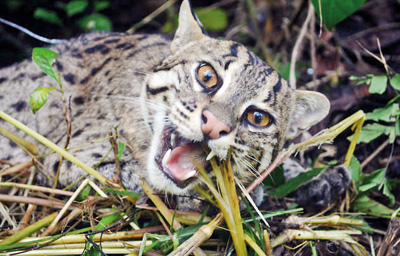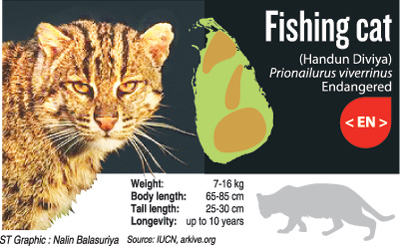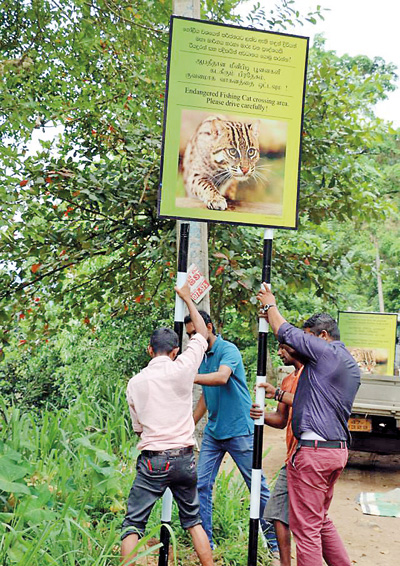News
Youths band together to protect elusive fishing cat
View(s):On the heels of last week’s story of innocent animals dying in collisions with speeding vehicles is a positive report of young people erecting road signs to prevent Sri Lanka’s second-largest wild cat falling prey to careless motorists. The first signs went up last week at Gannoruwa and Haloluwa critical fishing cat death sites in the Kandy district.

Fishing cat in pain - caught by wire trap in Pologolla and saved by AshanThudugala
The fishing cat (Prionailurus viverrinus), commonly known in Sri Lanka as hadun diviya, is the second largest wild cat in Sri Lanka and grows up to two and half feet in length. As the name implies, its primary meal is fish so it is found near wetlands or river ecosystems.
The international Red List on Conservation Status of Animals and Plants lists the fishing cat as “endangered”, just a few steps away from extinction.Fishing cats die on the roads due to their territorial behaviour as they move daily through a specific area. Most forests are now fragmented, so inevitably fishing cats need to cross roads, making them vulnerable to collision accidents, explained Ashan Thudugala of the Small Cat Conservation Alliance.
Mr. Thudugala, who spearheaded this project, said that based on data gathered over the past 18 months his group identified stretches of roads at Gannoruwa and Halloluwa as extremely prone to collisions between vehicles and these wild cats.
The fishing cat is a lovely animal but has earned a negative reputation in local communities as, being opportunistic hunters, they often raid poultry farms. Local populations of fishing cats are under threat due to poisoning, hunting pressure, and habitat destruction. Mr. Thudugala released a fishing cat that had become entangled in a wire trap in Polgolla a few weeks ago, indicating wire traps too could be a growing problem for this threatened wild cat.
 The fishing cat lives hidden in many habitats where they co-exist with humans, so Mr. Thudugala and the team organise awareness programme and youth camps to change the public’s views about this elusive cat that lives close to them.
The fishing cat lives hidden in many habitats where they co-exist with humans, so Mr. Thudugala and the team organise awareness programme and youth camps to change the public’s views about this elusive cat that lives close to them.
The first awareness session was held earlier this year for schoolchildren and the second for a selected number of university students who later began assisting the project.
At present, the Small Cat Conservation Alliance is focusing its study and data-gathering on fishing cats in the Kandy, Matale, Nuwara Eliya and Kegalle districts but is planning to expand efforts islandwide. Mr. Thudugala is thankful to those who supported the road sign project; they include personnel at the Department of Zoology at the University of Peradeniya, officers of the Road Development Authority, the police, and the in Mohamed Bin Zayed Species Conservation Fund. Such road signs will be placed throughout the country to protect this magnificent creature.
Instead of cursing the darkness, it is always better to light a candle – so the effort by Ashan Thudugala and his team to save these threatened animals is indeed commendable.
Saving wild cats in the concrete jungle

Ashan Thudugala conducting an awareness session for schoolchildren
The “small leopards” often reported to be seen crossing roads and running around Colombo’s remaining wetlands are, in fact, fishing cats – a very rare phenomenon as fishing cats are usually not found in densely populated areas anywhere in the world.
To find out how many fishing cats live in these urban areas and whether the population is healthy and, most importantly, to come up with a plan to conserve these fishing cats from rapid development, the Environmental Foundation Limited (EFL) launched the Urban Fishing Cat Conservation Project.
The first phase of the study, in 2006, resulted in confirmation that there were, in fact, fishing cats in urban wetlands. The results were breathtaking as the camera traps set by the research team revealed a very healthy population of fishing cats in Colombo’s urban wetlands.
The project is observing and recording the movement patterns and behaviour of urban fishing cats, Anya Ratnayake, a young EFL scientist, said. Researchers are using camera traps and have placed an electronic collar on a fishing cat to track its movements.
While post-war development is rapidly turning Colombo into a concrete jungle, the remaining urban wildlife remind us that we still have a chance to become a “garden city”, harbouring green areas that give urban wildlife a chance to survive.
 “The fishing cat can be the flagship species to raise this awareness among people and as an ‘umbrella species’ to conserve other biodiversity in the urban areas through good urban planning that integrates green areas,” said globally-renowned conservation scientist Dr. Eric Wickremanayake, who is involved in the wild cat conservation project.
“The fishing cat can be the flagship species to raise this awareness among people and as an ‘umbrella species’ to conserve other biodiversity in the urban areas through good urban planning that integrates green areas,” said globally-renowned conservation scientist Dr. Eric Wickremanayake, who is involved in the wild cat conservation project.
“The research being done by Anya and Ashan [Thudugala] will provide us with insights into the ecology and behaviour of this threatened species. We can then use this knowledge to integrate the habitat use and ecological requirements of fishing cats into urban planning and try to keep some of the natural habitats such as the wetlands and associated green areas along the waterways in cities, including in Colombo,” said Dr.Wickremanayake, pointing out that carnivores are losing ground all over the world as habitat is being lost and fragmented.
If you happen to come across a fishing cat, whether it crossed the road in front of you, was in your garden, in a marsh or a national park, or dead or injured at the side of the road, email the details to anya@efl.lk

